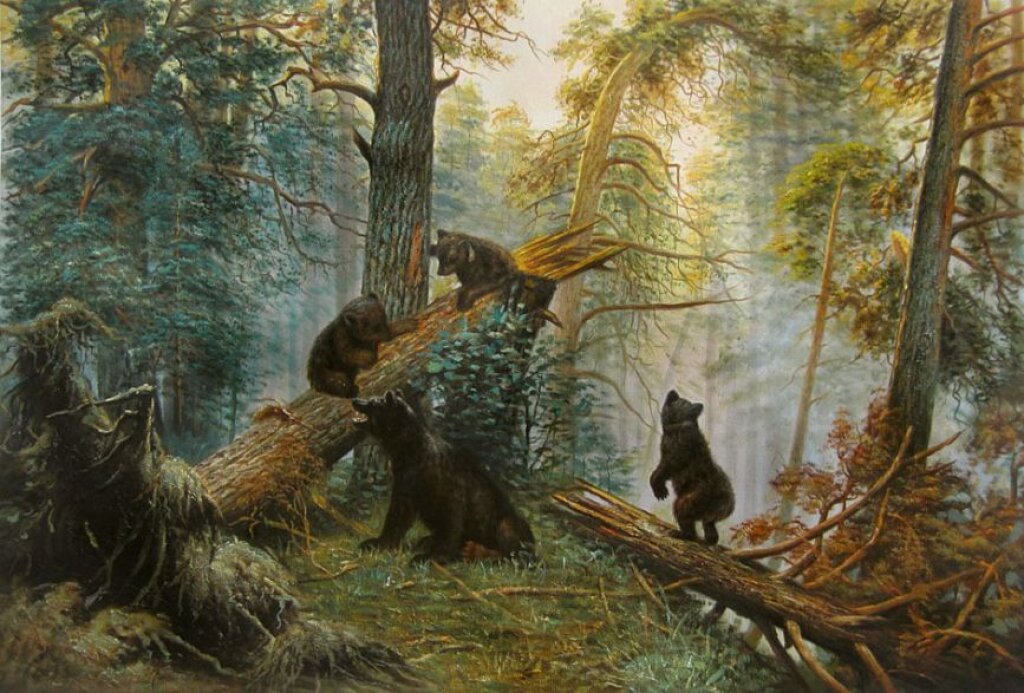Mary Orsak is a junior at Yale University majoring in Russian.
By the mid-nineteenth century, Russian artists began to seek inspiration from traditionally “Russian” subjects, such as vibrant peasant life and the immense, sprawling plains. Through this inward turn, these artists created what Christophy Ely called a “new visual image of rural Russia.” Ivan Shishkin’s Morning in a Pine Forest (1889) is perhaps one of the most recognizable representations of the vast expanses of the Russian landscape. Rejecting the vistas of European landscape painting, Shishkin focused his attention on native topography.
Shishkin's painting depicts an intimate scene of bear cubs frolicking among the pine trees as the morning mist pours in from the background. Standing at a distance, the viewer becomes witness to a fortuitous sight, since the cubs have not yet noticed the human in their midst and continue cavorting in peace. Since its creation, this romanticized and quintessentially Russian landscape image has become kitsch, adorning commonplace items like the wrappers of “Clumsy Bear” (Mishka kosolapy) chocolate candies. The commercial appeal of Shishkin’s bears demonstrates the artist’s ability to craft a compelling and specifically "Russian" aesthetic. Over time, Shishkin’s bears have become metonymic representations of Russia itself.
Yet the very commercialization of Shiskin’s painting has caused modern audiences to overlook its subversive message. Far from naively portraying an untroubled nature, Morning critiques the same industrialization that would later produce mass-marketed chocolates like “Clumsy Bear.” Although the bears have not yet turned their gaze toward the interlopers, the human impact on the scene is evident in the form of the uprooted tree, an early sign of Russia's rapid industrialization toward the end of the nineteenth century. Even as the truncated pine tree offers the bear cubs temporary amusement, it signals to the viewer that this idyllic scene, like the bear cubs standing on the broken branch, occupies a precarious position.
These same boreal forests and the brown bears that populate them face even greater threats today, as the exploitation of natural resources accelerates to meet growing consumer demand. According to NASA’s Land-Cover / Land-Use Change Program (LCLUC), Russian forests alone comprise twenty-five percent of the world’s total forested area, or 808.8 million hectares. Retaining nearly fifty percent of the Northern Hemisphere’s terrestrial carbon, these forests play an essential role in combating climate change. However, by ravaging 16.3 million acres a year — nearly double the 9.1 million acres destroyed annually in the Amazon — Russia leads the world in deforestation. Over time, the destruction of this critical carbon sink may result in warmer temperatures, which threatens the ecosystems of Russia’s boreal forests—including Shishkin’s bears.
Recent investigations have identified illegal logging on the Russian-Chinese border as the main culprit for the precipitous deforestation observers have recently documented. A 1998 restriction on commercial logging in the remaining forests along the Yangtze River forced Chinese timber titans to cross the border into Siberia. Corruption, a lack of oversight, and low prices of exported wood — about two dollars per hectare —have transformed Russian forests a mecca for illegal logging. For example, in Kansk, a town of 100,000 people on the bank of the Kan River, about a hundred Chinese-operated timber mills have opened just during the past five years. Russian logging accounts for nearly twenty percent of Chinese timber imports, and in 2017, China imported almost 200 million cubic meters of Russian wood.
While the United States has attempted to curtail the sale of illegally obtained timber, laws such as the 2008 amendment to the Lacey Act, which prohibits the exportation of any plant or plant product harvested in violation of the country’s natural-resource laws, remain challenging to enforce. Both Russian- and Chinese-owned logging companies––often with the aid of corrupt government officials––falsify records in order to claim that the wood was legally obtained.
Arson offers unscrupulous companies another alternative: the law allows companies to cull and sell scorched trees from protected areas. According to a 2008 study, fires caused over sixty-five percent of total forest loss. These fires not only threaten Russian forests, but also pose a danger to nearby residents. For example, a 2017 fire in Kansk destroyed more than fifty homes. Given the plethora of ways that companies can avoid violating the international laws that protect the globe’s dwindling forests, both Russia and China must play a more active part in prosecuting illegal logging.
Ultimately, as illegal practices annihilate Russian forests, Shishkin’s frolicking bears will face far greater challenges than simply falling off stumps and branches as they cavort in the morning mist. Within a few generations, Russians may not even recognize this scene of bears frolicking in a dense forest. Perhaps, in time, only Moscow's Tretyakov Gallery — home to Shishkin's masterpiece — will preserve this image of once-idyllic Russian forests. Without substantial cooperation between environmental groups and international law enforcement, Russia will not only lose its iconic bears and forests, but also a part of the national aesthetic nineteenth-century artists were so keen to develop.



